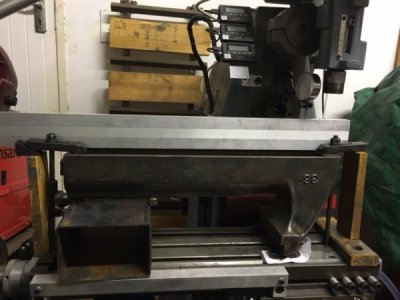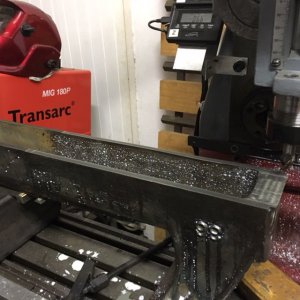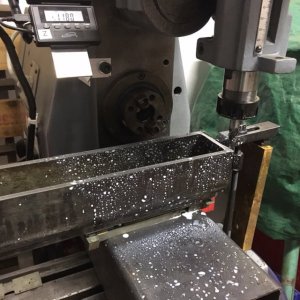- Joined
- Jun 26, 2014
- Messages
- 619
Well the old rusty Record No.36 Engineers Vice I brought has been torn apart and the main parts cleaned up.
As brought
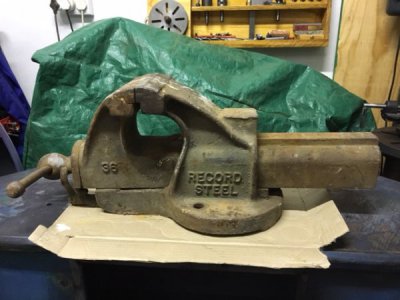
On closer inspection it appers to have a fair bit if wear and the moving jaw is about 3mm lower than the fixed jaw when the jaws are closed. In this vice the moving jaw casting only bears on a couple of areas of about 40mm at the front (under the "AND" in "ENGLAND" in teh photo) and 20mm at the rear of the body.
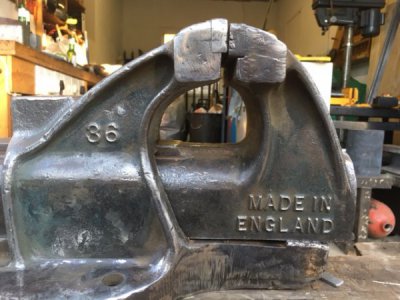
On further investigation when a stright edge is place along the bottom of the moving jaw casting the bottom has about 1,1mm of wear, mainly at the jaw end (as expected).
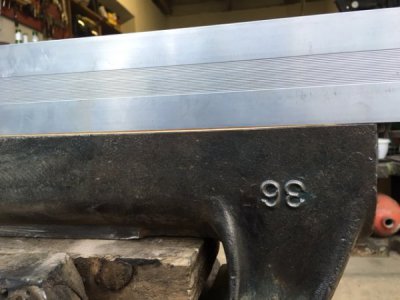
It take about 3.7mm of shimming at the front to bring the jaws to level when closed.
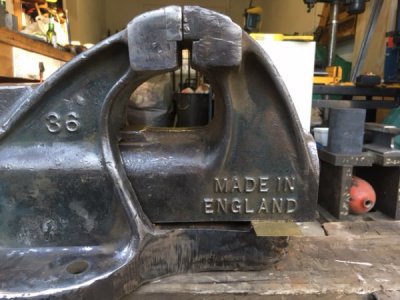
So as I see it the option are:
1) Leave it as is - probably a functional option but not going to happen as it will just annoy me too much that the jaws dont line up when closed.
2 ) Mill the moving jaw casting bottom back to flat and parallel, then built up the bearing areas at the front and back of the body to bring it back to the correct height - I know this is probably the proper way to go, but I hadn't intended this to be a major rebuild project.
3) Just build up the front bearing area to aling the jaws when closed and leave it at that - The moving jaw will move up and down slightly with respect to the fixed jaw as it is opened but I don't see that as a major problem. IS IT?
Then if I go for option 2 ) or 3) the question is how to build up the bearing surfaces on the body.
a) Overlay welding and machine back to the correct height is an option as it is a steel vice, but welding isn't my strong point.
b) Machining a shim plate, maybe brass, and fixing it in place with locktite, soldering/brasing or drilling and tapping for a countersunk screw. Seems a less riskey option and the shim could be replaced againg in future if needed.
I'm wanting to end up with a functional tool, not a show piece, and I still will have to do some machining/fabricating to get the quick relaese going again anyway . I have gone over the main parts with a wire wheel in the angle grinder, and then just removed some burrs and weld splatter with a flapper disk. I've left all the hammer blow marks as I think they add character and are the scars earned over a generation or so of use.
Open to other opionions/suggestions. What are the functional implication of not levelling up the moving jaw bottom?
As brought

On closer inspection it appers to have a fair bit if wear and the moving jaw is about 3mm lower than the fixed jaw when the jaws are closed. In this vice the moving jaw casting only bears on a couple of areas of about 40mm at the front (under the "AND" in "ENGLAND" in teh photo) and 20mm at the rear of the body.

On further investigation when a stright edge is place along the bottom of the moving jaw casting the bottom has about 1,1mm of wear, mainly at the jaw end (as expected).

It take about 3.7mm of shimming at the front to bring the jaws to level when closed.

So as I see it the option are:
1) Leave it as is - probably a functional option but not going to happen as it will just annoy me too much that the jaws dont line up when closed.
2 ) Mill the moving jaw casting bottom back to flat and parallel, then built up the bearing areas at the front and back of the body to bring it back to the correct height - I know this is probably the proper way to go, but I hadn't intended this to be a major rebuild project.
3) Just build up the front bearing area to aling the jaws when closed and leave it at that - The moving jaw will move up and down slightly with respect to the fixed jaw as it is opened but I don't see that as a major problem. IS IT?
Then if I go for option 2 ) or 3) the question is how to build up the bearing surfaces on the body.
a) Overlay welding and machine back to the correct height is an option as it is a steel vice, but welding isn't my strong point.
b) Machining a shim plate, maybe brass, and fixing it in place with locktite, soldering/brasing or drilling and tapping for a countersunk screw. Seems a less riskey option and the shim could be replaced againg in future if needed.
I'm wanting to end up with a functional tool, not a show piece, and I still will have to do some machining/fabricating to get the quick relaese going again anyway . I have gone over the main parts with a wire wheel in the angle grinder, and then just removed some burrs and weld splatter with a flapper disk. I've left all the hammer blow marks as I think they add character and are the scars earned over a generation or so of use.
Open to other opionions/suggestions. What are the functional implication of not levelling up the moving jaw bottom?

